This is an Ask IFAS publication for irrigation professionals, homeowners, Extension agents, Master Gardeners, scientists, and the general public. The objective is to provide basic information about rain sensors when incorporated into automatic irrigation systems.
Rain sensors — also called rain shutoff devices — are designed to interrupt the cycle of an automatic irrigation system controller when a specific amount of rainfall has occurred. They are small devices connected to the irrigation system controller and mounted in an open area where they are exposed to rainfall.
Some of the new irrigation controllers or timers have a special port which allows a rain sensor to be connected directly. If such a feature is not available, or the sensor does not work with a given controller, the sensor can always be "hard-wired" into the controller. After a specific amount of rainfall has occurred, the rain sensor will interrupt the system's common wire, which disables the solenoid valves until the sensor dries out or the delay feature resumes to allow irrigation mode.
Florida is one of just a few states with a rain sensor statute. The most recent version of this statute (2010) says the following: "Any person who operates an automatic landscape irrigation system shall properly install, maintain, and operate technology that inhibits or interrupts operation of the system during periods of sufficient moisture" (Florida Statute 373.62). Thus, all automatic landscape irrigation systems require a rain sensor or other shutoff device, such as a soil moisture sensor irrigation controller (see https://edis.ifas.ufl.edu/ae437) or an evapotranspiration (ET) controller.
Rain sensors are available wherever irrigation supplies are sold. A homeowner or irrigation professional can install them.
Benefits of a rain sensor include:
- Conservation of water — A rain sensor prevents irrigation after recent rain events.
- Money saved — A rain sensor reduces utility bills and lawn maintenance costs by interrupting the irrigation system after sufficient rainfall.
- Reduced wear on the irrigation system — The system runs only when necessary.
- Reduced disease and weed pressure — A sensor eliminates unnecessary irrigation events.
- Assistance in protection of surface and groundwater — A rain sensor reduces the runoff and deep percolation that carries pollutants, such as fertilizers and pesticides, into storm drains and groundwater.
Types of Devices
Rain sensors operate by one of two methods: 1) Devices that collect rainwater, measuring the water weight or the electrical conductivity of water; 2) Devices that measure the proportional expansion of hygroscopic disks.
Water weight: When a preset weight of water is collected in a small container or cup, the connection to the automatic irrigation valve is interrupted until the dish is emptied or a portion of water evaporates, reducing the weight below the critical level. A disadvantage of this device is that any other weight (debris, birds, frogs, etc.) can turn off the irrigation system. It also requires more maintenance (Figure 1).
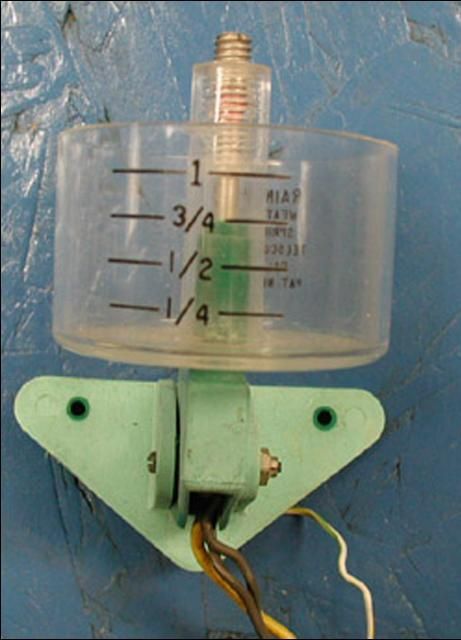
Credit: Dorota Haman, UF/IFAS
Electrical conductivity of water: A set of electrodes is used to detect the water level in a small collection dish. The distance between the bottom of the collection dish and the electrodes can be adjusted so the irrigation system is not switched off by small rain events. Typically, the sensor is set to detect rain events larger than 1/2 inch. As with the previous type, water may have to be removed from the dish, and debris may create some problems (Figure 2).
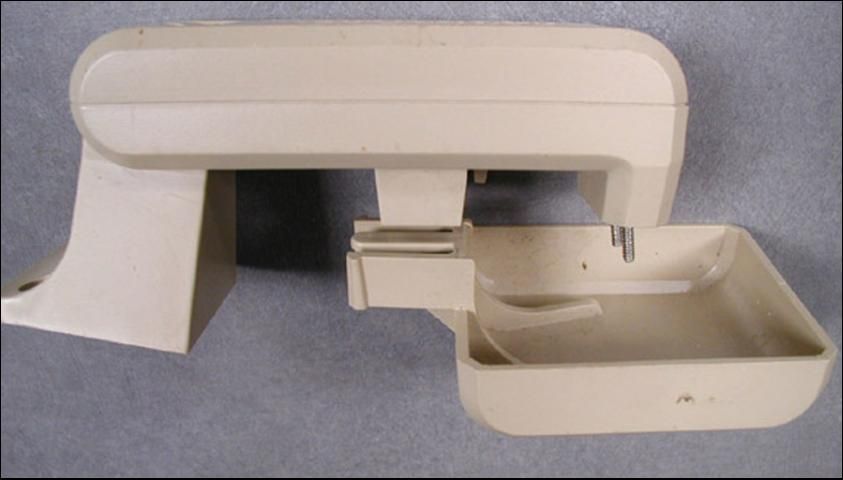
Credit: Dorota Haman, UF/IFAS
Expanding disks: These devices are the most popular rain sensors due to their low cost, simple installation, and low maintenance. There are both wired and wireless versions (Figure 3 and Figure 4). Some advantages of the wireless models include a quicker and easier installation, and additional mounting locations to choose from (up to 300 ft away from the receiver), especially for sites that present difficulty in routing wire as well as for retrofit applications.
Hygroscopic disks absorb water and expand proportionally to rainfall amount, triggering a pressure switch. The expansion space can be easily adjusted by rotation of the disk cover to a predetermined amount of rain required to trigger the switch. The amount of rain that will interrupt the irrigation system is marked on the adjustment cap (Figure 3 and Figure 4). The switch remains open (bypassing irrigation) as long as the disks are swollen. When the rain has stopped, the disks begin to dry out and contract, and the switch closes, allowing irrigation again.
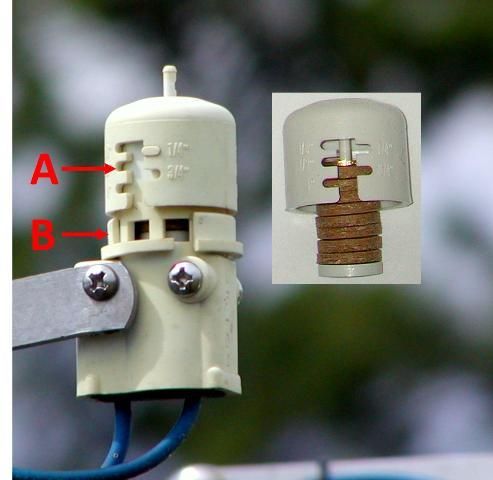
Credit: Bernard Cardenas, UF/IFAS
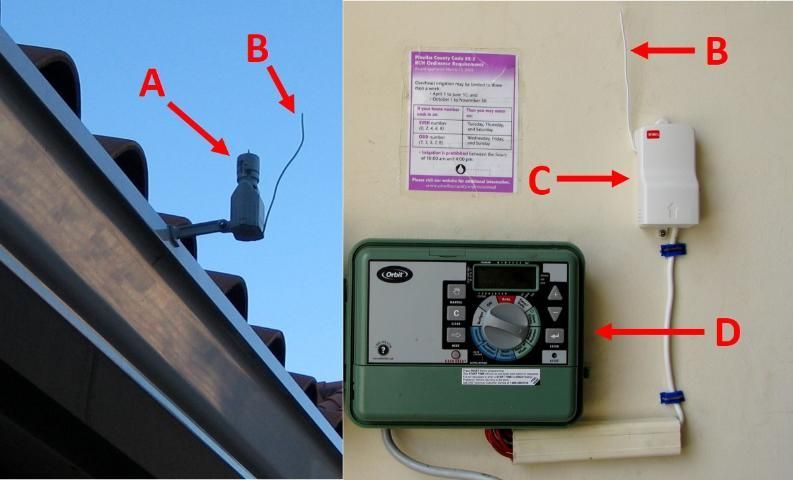
Credit: Bernard Cardenas, UF/IFAS
Installing the Device
The sensing portion of a shutoff device should be mounted where it will be exposed to unobstructed rainfall, but not in the path of sprinkler spray. It is typically installed near the roofline on the side of a building (Figure 4). However, it should not be mounted such that it comes into contact with water running directly off the roof. In addition, it is important that trees, overhangs, and awnings are not blocking direct rainfall onto the device. If vandalism is not a threat, rain sensors can be mounted lower on a fence post or deck railing. However, the closer the wired sensor is to the controller, the shorter the wire and the lower the chance for wire breaks.
If a given sensor does not work with an irrigation controller that is already installed, it can always be "hard-wired" into the controller. This is done by wiring the rain sensor in series with the common wire.
Testing
Rain sensors should be checked at least once a year. First, if the irrigation controller has a port for the rain sensor, check that the sensor switch is in the “Active” position (Figure 5). Then, turn on an irrigation zone and, while it is irrigating, spray the sensor with a nearby hose. Rain sensors with weighing containers or cups (Figure 1) or with electrodes (Figure 2) should turn off the irrigation system almost immediately; sensors with expanding disks should turn off the system after a few minutes (Figure 3 and Figure 4). If the sensor fails to do so, there might be an issue.
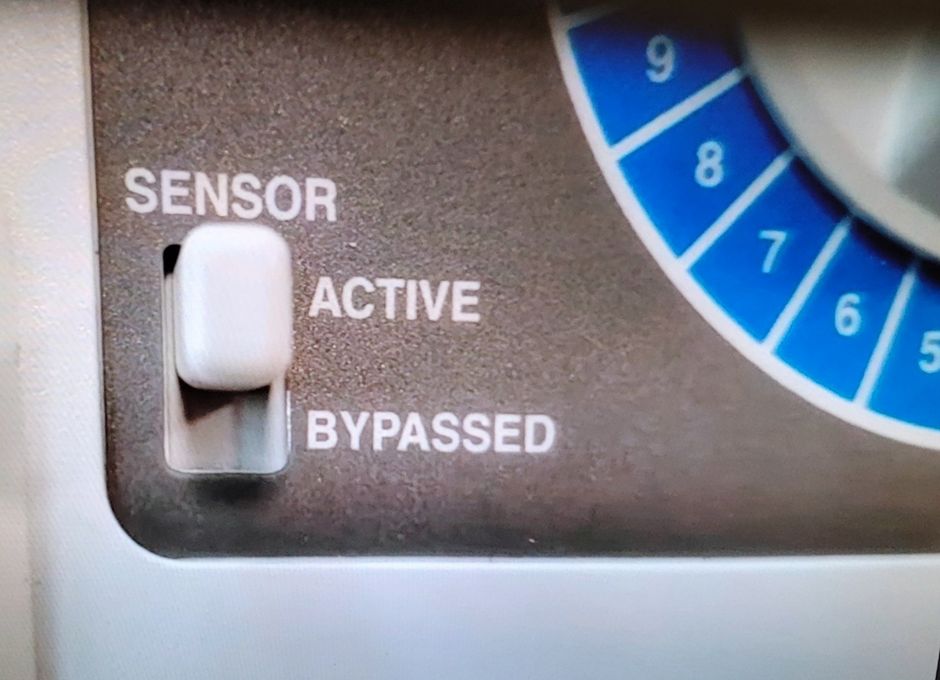
Credit: Bernard Cardenas, UF/IFAS
Some general troubleshooting tips include cleaning the sensor (especially sensors with a weighing container and sensors with electrodes), relocating it to a better position, and making sure that all wires are intact. For rain sensors with expanding disks, replace the disks with new ones (note: it is recommended to exchange the disks at least every two years for proper functionality). For wireless rain sensors, check the connection between the receiver and the irrigation controller (Figure 4), and replace the battery. If the previously mentioned tips do not work, the entire unit might need to be replaced.
Potential Water and Cost Savings
The amount of water that can be saved using rain shutoff devices varies, but in a year with average rainfall, savings are usually substantial. There are several factors involved in determining how much a rain sensor can reduce water usage: how often it rains, whether or not the controller is left on for automatic operation, the frequency of irrigation cycles, and the amount of water applied per cycle. If the water costs and the amount of water applied per watering cycle by the whole system are known, it is easy to calculate how much money is being saved each time the sensor interrupts the watering cycle because of rainfall.
As an example, if a system irrigates 1/2 acre of turf and is set to run each zone so that 1/2 inch of water is applied per cycle, one can calculate that 13,576 gallons are being applied over the 1/2 acre of turf per cycle. Assuming water costs $2.00 per 1,000 gallons, the savings will be $27.15 every time the sensor eliminates an irrigation event. Even more importantly, 13,576 gallons that would be lost to deep percolation or runoff will be saved. If this amount is multiplied by the number of substantial rainfalls that occur in the area over one growing season, a significant amount of money and water can be saved.
Research Results and Recommendations
Cardenas-Lailhacar and Dukes (2008) showed that smaller set points led to the highest water savings. Thus, homeowners should use the smallest set point possible, with 1/8 inch being the lowest on most devices. In any case, we recommend not exceeding the set point of 1/4 inch. This same study estimated a payback period of less than a year. Likewise, Cardenas et al. (2020), after testing an expanding disk rain sensor over 16 months, calculated the payback period to be four months.
Experiments carried out with different brands and settings showed that the average rain sensor dry-out time was not different between the rain sensor brands tested, which was around 19 hours after the rain stopped. This timeframe was shorter than the dry-out characteristics of the different soil textures modeled (Cardenas and Dukes 2018). In practice, water savings have not been found significant (see publications at https://abe.ufl.edu/faculty/mdukes/publications/).
References
Cardenas, B., and M. D. Dukes. 2018. “Dry‐Out Periods of Rain Sensors vs. Soil Dry‐Out: Water Saving Potential and Recommendations.” Vadose Zone Journal 17 (1): 1–8. https://doi.org/10.2136/vzj2017.10.0185
Cardenas, B., K. W. Migliaccio, M. D. Dukes, I. Hahus, and J. K. Kruse. 2020. “Irrigation Savings from Smart Irrigation Technologies and a Smartphone App on Turfgrass.” Transactions of the ASABE 63 (6): 1697–1709. https://doi.org/10.13031/trans.13903
Cardenas-Lailhacar, B., and M. D. Dukes. 2008. "Expanding Disk Rain Sensor Performance and Potential Irrigation Savings." Journal of Irrigation and Drainage Engineering 134 (1): 67–73. https://doi.org/10.1061/(ASCE)0733-9437(2008)134:1(67)